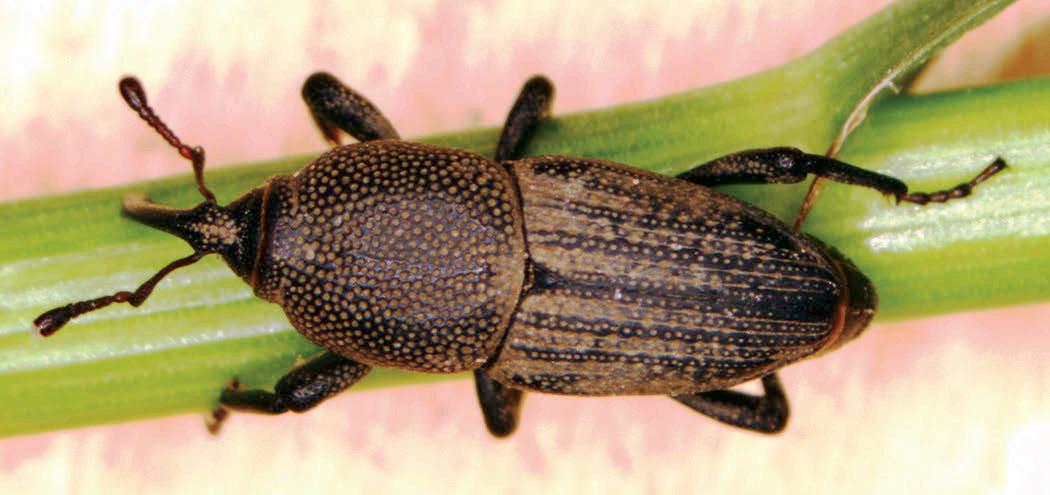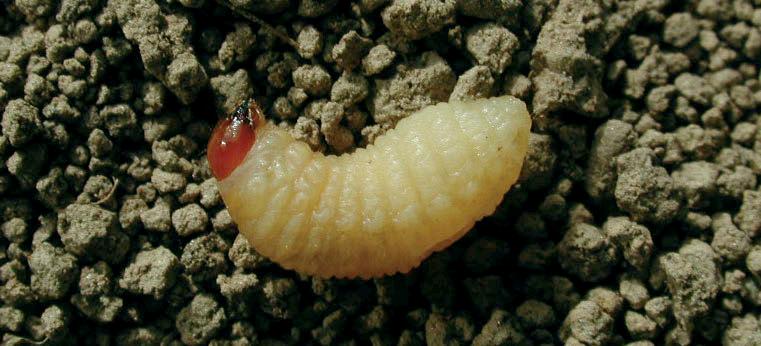
6 minute read
Rooted in Research—Polycultures, Bluegrass Billbugs, Endophytes Overseeding, and More!
ROOTED IN RESEARCH
POLYCULTURES, BLUEGRASS BILLBUGS, ENDOPHYTES, OVERSEEDING, AND MORE!
By Cale A. Bigelow, PhD
Welcome back to another installment of “Rooted in Research,” where we take a deep dive into turf research you can use or at the very least glean some fancy scientific “big words” to impress your friends and family over some of your favorite beverages. For this installment I wanted to highlight the potential benefits of growing a diverse stand of cool-season turfgrass species. When cultivating a mixture of different species this is often referred to as a polystand or polyculture. In agroecosystems, polycultures have been studied and implemented for many years primarily as a non-chemical strategy for reducing pests. For example, intercropping involves growing two or more cash crops at the same time or sometimes with various cover crops. While most often utilized for pest management, this cropping strategy can sometimes improve soil fertility and nutrient cycling. With intercropping a pest susceptible host and non-host species are interspersed and the species combination is successful in reducing pest damage compared to the pest susceptible monostand. The benefits occur due to alterations in insect movement, foraging behaviors, modifying host plant suitability, or simply strengthening the action of natural enemies (Coll and Bottrell, 1994).
In lawn systems, genetically diverse polystands have often been specified for new plantings. Various species mixtures like a traditional “sun-shade” seed mixture (e.g., Kentucky bluegrass plus fineleaf fescue) or mixtures where Kentucky bluegrass is combined with perennial ryegrass or turftype tall fescue are fairly common seed mixtures. The logic is that the broader tolerance of the species mixture and cultivar blends to environmental stress will decrease the likelihood of stand decline due to disease or insect infestations (Watschke and Schmidt, 1992). In short, this genetic diversity provides better turf persistence and durability across a wide range of growing conditions and pest pressures. One possibility for further enhancing pest and environmental stress tolerances when developing a species mixture is to include endophyte enhanced grass seed. You might be asking yourself, “What’s the heck is an endophyte?” Endophytes are a systemic, seed-borne fungus that are described as mutualists. Often when we hear fungi and turfgrass we only consider the possible negative effects a fungus might have on turfgrass health. These endophytic fungi provide benefits that are quite the opposite. In this mutualistic relationship the grass plants harbor the fungus in the stem tissue, providing a protective place to live, while also supplying water and nutrients. In return, the endophytes offer a number of possible benefits such as improved vigor and drought tolerance, resistance to various diseases or shoot feeding insects like caterpillars. The grass species most often associated with endophyte enhancement include the ryegrasses and the fescue species (e.g., tall and fineleaf). In perennial ryegrass Neotyphodium spp., is the most commonly associated fungal endophyte. In addition to providing resistance to various caterpillar insects it also provides resistance to the bluegrass billbug, which can be a very serious lawn pest. Bluegrass billbugs lay their eggs (the entomologists like to use the fancy word, “oviposit”) into the stem of grasses in the spring. The very hungry emerging larvae tunnel their way through the stem tissue potentially causing catastrophic plant destruction along the way. Fungal endophytes produce chemical products called “alkaloids” which in simple terms are not very tasty to the insects. A common alkaloid you might be familiar with is caffeine, which is part of the xanthine family. Caffeine has a stimulating effect on humans, but too much can also have negative consequences, especially on the human gastrointestinal system.
Remember “the dose makes the poison.” So why all the buildup about things like genetic diversity, polyculture, endophytes, oviposition, and bluegrass billbugs? Well, according to my turf entomologist colleague here at Purdue, Dr. Doug Richmond, billbugs affect roughly half of all home lawns in this part of the Midwest. This makes them one of, if not the most, common turfgrass-infesting insects. Billbug damage is often overlooked and confused with issues like soil compaction, drought/summer stress, nematodes, “summer disease,” or attributed to other insects like the white grub. While there are four major billbug species affecting turfgrass, the bluegrass billbug is the species infesting cool-season grasses like Kentucky bluegrass, perennial ryegrass, fine fescue, and tall fescue. Billbugs are part of a group of insects called weevils in the genus Sphenophorus. They are about onethird inch in size and easily recognized by the presence of a long snout on the front of the head. (See Figure 1.)
Figure 1: Overview of the bluegrass billbug adult.
Billbugs spend their winters in thatch or surface debris, soil cracks and crevices, or other plant debris in and around structures such as sidewalks, driveways, and buildings. They become active in April or May as soil temperatures warm and eventually deposit their eggs in stem tissue and the legless larvae begin their feeding (See Figure 2).
Figure 2: A typical larvae of bluegrass billbug.
While a number of insecticides can be used to suppress billbug populations there are effective non-chemical options for chronically affected lawns. This leads me to a field research study conducted by Drs. Richmond, Niemczyk, and Shetlar at Ohio State and a paper they published entitled, “Overseeding endophytic perennial ryegrass into stands of Kentucky bluegrass to manage bluegrass billbug,” in the Journal of Economic Entomology. These researchers posed the question: “What would happen to billbug damage if we overseeded a billbug susceptible Kentucky bluegrass lawn with endophyte enhanced ryegrass?” The hypothesis being that by introducing perennial ryegrass this effectively increases genetic diversity and provides a grass less sensitive to billbug feeding. Further, the use of endophyte enhanced ryegrass might have an additive effect for billbug damage. In their study, conducted in Eastern Ohio, they slit-seeded two ryegrasses with differing endophyte infection percentages (63 versus 95 percent) at two seeding rates in October. Over the next few years, they measured things such as turf appearance, turf species composition, and of course billbug population density. What they were able to demonstrate is that overseeding an existing Kentucky bluegrass with endophyte-enhanced perennial ryegrass was an effective strategy to manage the bluegrass billbug. They also stressed that if you plan to use endophytic grasses as an overseeding strategy it is extremely important to use fresh seed (or properly stored seed) containing sufficiently high amounts of viable endophyte. This study quantified important practical results and illustrated the benefits of fall lawn overseeding with superior grasses and cultivars. In addition to suppressing insects like billbugs, this practice may also be beneficial in terms of drought/heat tolerance and non-chemically suppressing other pests like disease. Until next time, be well, be safe and hopefully we will bump into each other during the upcoming winter education season.


Note: Dr. Richmond has an excellent factsheet related to billbug management which can be found at the website link that follows. https://extension.entm.purdue.edu/ publications/E-266/E-266.html
References:
Coll, M. and D.G. Bottrell. 1994. Effects of non-host plants on insect herbivore in diverse habitats. Ecology 75:723-731. Richmond, D.S., H.D. Niemczyk and D.J. Shetlar. 2000. Overseeding endophytic perennial ryegrass into stands of Kentucky
bluegrass to manage bluegrass billbug (Coleoptera: Curculionidae) J. Econ. Entomol. 93:1662-1668. doi:10.1603/0022-0493-93.6.1662.
Watschke, T.L. and R.E. Schmidt. 1992. Ecological aspects of turfgrass communities. pp.129-162. In D.V. Waddington, R.N. Carrow and R.C. Shearman (eds.) Turfgrass. ASA-CSSA-SSSA, Madison, WI.
Cale A. Bigelow, PhD, is a professor of Turf Science and Ecology in the Department of Horticulture and Landscape Architecture at Purdue University in Indiana. Mike Fidanza, PhD, is a professor of Plant and Soil Sciences at Penn State University, Berks Campus. They are teaming to provide a Rooted in Research article for each issue of Turf News. All photos courtesy of Dr. Doug S. Richmond.









